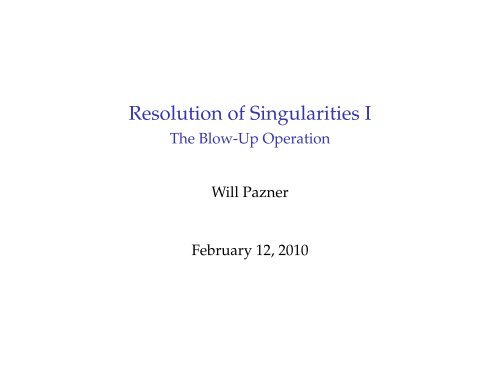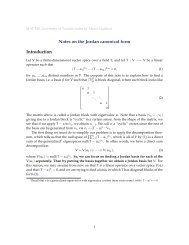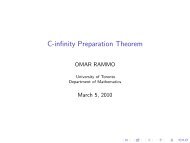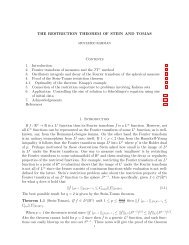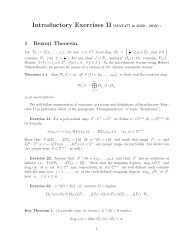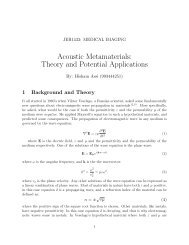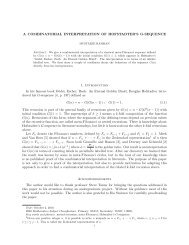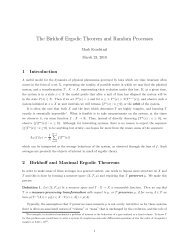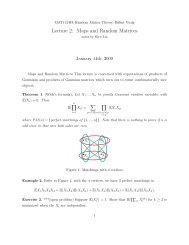Resolution of Singularities I - The Blow-Up Operation - wiki
Resolution of Singularities I - The Blow-Up Operation - wiki
Resolution of Singularities I - The Blow-Up Operation - wiki
Create successful ePaper yourself
Turn your PDF publications into a flip-book with our unique Google optimized e-Paper software.
<strong>Resolution</strong> <strong>of</strong> <strong>Singularities</strong> I<br />
<strong>The</strong> <strong>Blow</strong>-<strong>Up</strong> <strong>Operation</strong><br />
Will Pazner<br />
February 12, 2010
1. Set up.<br />
k := field <strong>of</strong> characteristic 0<br />
Defn. Algebraic variety k n ⊃ X := zeros <strong>of</strong> f1, . . . , f k ∈ Pol<br />
Defn. Multiplicity<br />
<br />
<strong>of</strong> f at a is<br />
µa(f ) := min<br />
d :<br />
∂ d f<br />
∂x d 1<br />
i1 ...∂x d k<br />
i k<br />
Defn. a ∈ Sing(V(f )) ⇐⇒ µa(f ) > 1<br />
(a) 0 for d1 + . . . + d k = d<br />
e.g. Cone = V(f = x 2 − y 2 − z 2 ) Sing(Cone) = {0} µ0(f ) = 2
Σ<br />
For (x, y) ∈ X, (x, y) ↦→ (0, 0)<br />
Slope y ′ = y<br />
x → 0 ⇐⇒ line[x : y] → x-axis
2. Enticement.<br />
Take “any” f on manifold M (f is in some fixed category, e.g.<br />
polynomials, or analytic functions)<br />
<strong>The</strong>n ∃ proper morphism φ : M ′ → M<br />
(φ is a composition <strong>of</strong> “quadratic” maps)<br />
f ◦ φ is locally a monomial (up to invertible factor) on M<br />
Furthermore, even J(φ) · (f ◦ φ) is locally a monomial
3. <strong>Blow</strong>ing-up: key instrument.<br />
C ↩→ M manifolds. U ⊂ M coordinate chart.<br />
C = V(I), ideal I = (f0, . . . , fm) on U.<br />
[f ] : U\C ∋ x ↦→ [f0(x) : . . . : fm(x)] ∈ P m<br />
[ξ]<br />
BlI U := closure graph [f ] ⊂ U × P m<br />
↓σ ↓π<br />
U<br />
id<br />
−−−−−−−−−−−−→ U<br />
closure graph [f ] = {(x, [ξ]) : ξjfi(x) = ξifj(x)}i,j≤m<br />
So σ : BlI U → U where σ = π| BlI U.
4.<br />
U × P m = <br />
j V ′ j V ′ j := {ξj 0}. U ′ j := V′ j ∩ BlI U.<br />
Say I := (x1, . . . , xm) where (x1, . . . , xn) are coordinates on U.<br />
So C = V(I) = {(x) : x1 = . . . = xm = 0}.<br />
U ′ j = V′ j ∩ {ξjxi = ξixj}i,j≤m So coordinates on U ′ j are:<br />
Furthermore<br />
yj = xj<br />
yi = ξi/ξj<br />
yi = xi<br />
e.g. on chart U ′ j<br />
for 1 ≤ i ≤ m, i j<br />
otherwise<br />
U ′ j \U′ i = {yi = 0}<br />
and U ′ j ∩ σ−1 (C) = {yj = 0}<br />
σ| U ′ j : xj = yj xi = yjyi (1 ≤ i ≤ m, i j) xi = yi (otherwise)
5. Example: f := x n − y m = 0, X = {f = 0} ⊂ k 2<br />
Assume gcd(n, m) = 1, n > m.<br />
I = (x, y), C = {0} = Sing(X)<br />
Fact: σ −1 (X\C) ⊂ U ′ x<br />
f ◦ σ(x0, y0) = x n 0 − (x0y0) m = x m 0 (xn−m<br />
0<br />
σ| U ′ x : (x0, y0) ↦→ (x0, x0y0)<br />
− ym 0 ) for (x0, y0) ∈ U ′ x<br />
f ′ := x −m<br />
0 (f ◦ σ) = x n−m<br />
0 − ym 0 , σ−1 (C) = {x0 = 0}.<br />
Summarizing. σ −1 (X) ∩ U ′ x = {x0 = 0} ∪ {f ′ = 0}<br />
Repeat. By Euclidean Algorithm:<br />
Finitely many blowups =⇒ Xn has no singularities.
6. Effect <strong>of</strong> blowing up.<br />
M ⊃ X := {x: f (x) = 0} a ∈ X d := µa(f )<br />
Linear coordinate change =⇒ a = 0 and ∂df ∂xd (a) 0 Why:<br />
n<br />
f = ∑|α|≥d cαx α =⇒ ∑|α|=d cαx α 0, x ∈ ξ for some line ξ Make<br />
ξ into the xn-axis.<br />
˜x := (x1, . . . , xn−1). Near a can write<br />
f (x) = c0(˜x) + c1(˜x)xn + . . . + c d−1(˜x)x d−1<br />
n<br />
+ c d(x)x d n<br />
cd(x) 0. Im.F.T. =⇒ ∂d−1f (x) ∼ (xn − h(˜x)) =: x ′ n new coord.<br />
N :=<br />
∂x d−1<br />
n<br />
∂x d−1<br />
<br />
(x) = 0 , ci :=<br />
n<br />
1<br />
i! · ∂if ∂xi n<br />
<br />
x : ∂d−1 f<br />
<br />
<br />
N , i < d
7. <strong>Blow</strong>ing-up with C = {x1 = . . . = xm = xn = 0}<br />
Two types <strong>of</strong> charts: U ′ n and all the others.<br />
On U ′ n\ m j=1 U ′ j = {y1 = . . . = ym = 0} we show later f ′ 0.<br />
In coordinate chart U ′ j for 1 ≤ j ≤ m. Say j = 1.<br />
σ −1 (C) ∩ U ′ 1 = {y1 = 0}.<br />
c ′ i := yi−d<br />
1<br />
(ci ◦ σ) =⇒ c ′ i = c′ i (˜y), for i < d<br />
˜y := (y1, . . . , yn−1)<br />
f ′ := y −d<br />
1 (f ◦ σ) = c′ 0(˜y) + . . . + c ′ d−2 (˜y)yd−2 n + c ′ d (y)ydn c ′ d (y) 0 ∀y ∈ σ−1 (C) ∩ U ′ 1<br />
In particular µy(f ′ ) ≤ d.<br />
since ∂σn<br />
∂yn (y) = y1 = 0
8. On U ′ n\ m j=1 U ′ j = {y1 = . . . = ym = 0} ∋ y<br />
f ′ (y) := y−d n (f ◦ σ)(y) = c ′ 0 (y) + c′ 1 (y) + . . . + c′ d (y),<br />
where c ′ i := yi−d n (ci ◦ σ)<br />
µx(ci) ≥ d − i ∀x ∈ C, i.e.<br />
ci = ∑<br />
|α|≥d−i<br />
ciα (xm+1, . . . , xn−1) · x α1<br />
1 . . . xαm m<br />
Recall (x1, . . . , xm) = yn · (y1, . . . , ym) =⇒<br />
<br />
(y) 0<br />
=⇒ µy(f<br />
(y) = 0<br />
′ ) = 0 ≤ d<br />
c ′ d<br />
c ′ j<br />
Corollary. d = µa(f ) =⇒ µ a ′(f ′ ) ≤ µa(f ) ∀a ′ ∈ σ −1 (a).<br />
In fact, f ′ (y) 0 for y ∈ U ′ n\ <br />
jn U ′ j<br />
Conclusion: we don’t need to consider U ′ n chart.
9. Monomial assumption<br />
Assumption: (proved later using induction on dimension)<br />
∃Ω ∈ Q n−1 such that ci(˜x) d!/(d−i) = (˜x Ω ) d! · c ∗ i (˜x)<br />
Where ˜x Ω := x Ω1<br />
1 . . . x Ωn−1<br />
n−1 , d!Ωi ∈ N with some c∗ i (˜x) 0 ∀˜x.<br />
S (f ,d) := {x: µx(f ) = d} = {x: xn = 0 and µ˜x(˜x Ω ) ≥ 1} = <br />
J ZJ<br />
ZJ := {xn = 0, xj = 0 ∀j ∈ J}, for J s.th. ∑j∈J Ωj ≥ 1<br />
<br />
Suffices to consider J s.th. 0 ≤<br />
∑j∈J Ωj<br />
<br />
− 1 < Ω k ∀k (∗)<br />
Choose C = ZJ for any such J. Say J = {1, . . . , m}.
10. Multiplicity decreases.<br />
We will show |Ω| := ∑ n−1<br />
k=1 Ωk decreases at points<br />
y ∈ σ−1 (a) with µ a ′(f ′ ) = µa(f ) = d. On U ′ j say j = 1<br />
Reminder: corollary =⇒ µy(f ′ ) ≤ d.<br />
Either multiplicity decreases (done) or multiplicities are equal.<br />
c ′ i (˜y)d!/(d−i) = (y (i−d)d!/(d−i)<br />
1 )(σ(˜y) Ω ) d! (c ∗ i<br />
= (y (∑k∈J Ωk)−1 1 y Ω2<br />
2 . . . y Ωn−1<br />
n−1 )d! (c ∗ i<br />
◦ σ(˜y))<br />
◦ σ(˜y))<br />
Recall:<br />
f ′ = c ′ 0 (˜y) + . . . + c′ d−2 (˜y)yd−2 n + c ′ d (y)yd n with c ′ d (y) 0 ∀y
11. If µ a ′(f ′ ) = d then yn = 0<br />
Ω ′ := (∑ m k=1 Ω k − 1, Ω2, . . . , Ωn−1)<br />
<strong>The</strong>n (˜y Ω′ ) d! | (c ′ i )d!/(d−i) ∀i with some (c∗ i ◦ σ)(˜y) 0 ∀˜y<br />
i.e. f ′ satisfies monomial assumption<br />
|Ω ′ | < |Ω| by choice <strong>of</strong> C (see inequality (∗)) =⇒<br />
(µ a ′(f ′ ), |Ω ′ |) < (µa(f ), |Ω|) (ordered lexicographically)<br />
Conclusion: multiplicity d decreases when ∑ n+1<br />
k=1 Ω k < 1.<br />
After blowing up, |Ω ′ | − |Ω| ≥ 1/d! since d!Ωi ∈ N<br />
=⇒ after at most d!|Ω| blowings-up, multiplicity decreases.
12. Induction on dim. =⇒ monomial assumption<br />
A f (˜x) := ∏ ′d−2<br />
i=0 c d!/(d−i)<br />
i<br />
(˜x) × (‘their’ differences)<br />
∏ ′ means include only nonzero factors<br />
Desing. in (n − 1)-dim =⇒ ∃φ = σ1 ◦ · · · ◦ σℓ such that<br />
(A f ◦ φ)(˜y) is locally monomial<br />
So, W.L.O.G. may assume<br />
<br />
each factor<br />
<br />
in the product is locally a<br />
∂d−1f monomial on N = (x) = 0 .<br />
∂x d−1<br />
n<br />
Lemma (to come) =⇒ exponents are totally ordered<br />
=⇒ ∃Ω such that (˜x Ω ) d! | (ci) d!/(d−i)
13. Lemma<br />
α, β, γ ∈ N n a(x), b(x), c(x) invertible<br />
a(x)x α − b(x)x β = c(x)x γ =⇒<br />
either αi ≤ βi ∀i<br />
or βi ≤ αi ∀i<br />
Pro<strong>of</strong>. If α k ≤ β k ∀k done. Otherwise ∃k s.t. β k < α k.<br />
Write α − β k = (α1, . . . , α k − β k, . . . , αn)<br />
a(x)x α−β k − b(x)x β−β k = c(x)x γ−β k. Evaluate at x k = 0<br />
=⇒ c(x)x γ−β k = −b(x)x β−β k 0 =⇒ β = γ<br />
=⇒ a(x)x α = (b(x) + c(x))x β .<br />
If ∃j s.t. αj < βj, proceed similarly. Done
14. I cheated: used stronger induction than proved<br />
I ignored exceptional factors that accumulated before the ‘last’<br />
drop in multiplicity <strong>of</strong> f ↦→ f ′ := y−d exc(f ◦ σ) (say ‘old’<br />
exceptional divisors).<br />
As a consequence, choices <strong>of</strong> centres might not have normal<br />
crossings with with ‘old’ exceptional divisors as well.<br />
Say E old := {H k : H k old exc.}<br />
E old(a) := {H k ∈ E old : a ∈ H k} s(a) := #E old(a)<br />
{g k = 0} := H k =⇒ d g k 0
15.<br />
Choose xn such that both<br />
∂df ∂xd (a) 0<br />
n<br />
and<br />
∂xn<br />
Consider besides cj(˜x) = ∂j <br />
f <br />
, 0 ≤ j ≤ d − 2<br />
all a k = g k| N .<br />
Now,<br />
A f (˜x) := ∏ ′ c d!/(d−j)<br />
j<br />
∂gk (a) 0 ∀Hk ∈ Eold(a) ∂x j <br />
n N<br />
(˜x) × ∏ ′ a d!<br />
k (˜x) × (‘their’ differences)<br />
Before: (µ a ′(f ′ ), |Ω ′ |) < (µa(f ), |Ω|) for a ′ ∈ σ −1 (a)<br />
Now: (µ a ′(f ′ ), s(a ′ ), |Ω ′ |) < (µa(f ), s(a), |Ω|)


